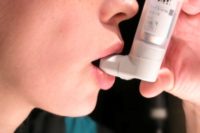CDC program to combat climate change-related EHS threats turns ten

The CDC’s Climate and Health Program is celebrating 10 years of supporting state, tribal, local, and territorial public health agencies as they prepare for the continuing health impacts of a changing climate.
In 2019 the program provided communities with new resources, tools, and peer-reviewed publications addressing the impacts of climate hazards. This work increased the nation’s preparedness to respond to the health effects of extreme temperatures, wildfires, drought, and flooding.
“Climate change is the biggest environmental health challenge of our time,” said Patrick Breysse, director of CDC’s National Center of Environmental Health and the Agency for Toxic Substances and Disease Registry. “CDC is proud of the collaborative work states, cities, counties, territories, and tribes are doing to develop and implement adaptation plans to protect at-risk populations and communities.”
The Climate and Health Program was established in 2009; in 2010, CDC awarded funding to 10 grantees through CDC’s Climate-Ready States and Cities Initiative. The program is now helping 18 grantees around the nation use the five-step Building Resilience Against Climate Effects (BRACE) framework to identify climate impacts in their communities, potential health effects associated with these impacts, and at-risk populations and locations.
“While coastal states might be worried about flooding associated with sea-level rise or a hurricane, a health department in the Southwest might be planning for heatwaves and drought. We provide them with information and data so they can develop and implement solutions that best fit their local needs,” Breysse said.
Expanded funding to address environmental health challenges
In early 2019, the Climate and Health Program extended its reach through partnerships with non-profit health organizations. These organizations provided funding for 12 new climate and health mini-grants, as well as implemented climate-adaptation strategies to reach vulnerable populations. The program now provides funding to health departments in 29 jurisdictions. Partnerships with the American Public Health Association and American Lung Association, along with those detailed below, are critical to the success of the climate and health program. These new awards range from $5,000 to $50,000 and support a variety of climate and health adaptation activities ranging from preparing for extreme heat to developing a state-wide data tool to support local adaptation planning.
In partnership with the National Indian Health Board, CDC selected four new awardees for the Climate Ready Tribes initiative. Three Tribes will be re-funded for a second year to continue their work into 2020:
- The Lummi Nation (Washington State) is developing plans to protect their community from harmful algal blooms and toxins in shellfish that are influenced by warming waters.
- The Pala Band of Mission Indians (California) is working on adaptation planning and outreach.
- The Sitka Tribe of Alaska is coordinating a regional project to monitor shellfish contamination.
- In addition, the Kaw Nation (Oklahoma) received a one-time mini-grant for a project focused on local community education and outreach related to climate and health.
These new awardees join the previous cohort:
- The Swinomish Indian Tribal Community (Washington State).
- The Village of Wainwright (Alaska).
- The Blackfeet Nation (Montana).
Three additional new mini-grants to support Tribal climate and health communication needs will be awarded in December 2019.
Partnerships for environmental health
The Climate and Health Program partnered with the Council of State and Territorial Epidemiologists to award three one-time grants in early 2019 to assess climate and respiratory health issues. The grantees are San Mateo County Health, Propeller Health, and the Washington State Department of Health.
- San Mateo is assessing the magnitude and trends of asthma burden in San Mateo County and adapting the Community Health Vulnerability Index for their jurisdiction.
- Propeller Health is evaluating the impact of respiratory health communication tools on patient health, specifically mobile applications, and developing health outreach guidance to lessen impacts of asthma.
- Washington state is developing best practice guidance on wildfire communications outreach and testing the utility of low-cost air quality sensors during wildfires.
Washington state also received an additional grant from CDC in partnership with the Association of State and Territorial Health Officials to aid development of regional climate and health profiles and climate-related risk communication efforts.
CDC’s Climate and Health Program also worked with the National Association of County and City Health Officials to award two mini-grants to support local adaptation efforts:
- The Boston Public Health Commission developed heat awareness materials and translated them into 10 languages to assist a wide range of communities across the city.
- The Marquette County Health Department (Michigan) developed a “Public Health Response to Flooding Disasters” plan to protect their population from increasing extreme rain events.
In partnership with the National Environmental Health Association, CDC awarded two additional climate and health mini-grants with a focus on data accessibility:
- The Minnesota Department of Health developed an online climate and health vulnerability assessment tool to allow communities across the state to visualize and analyze health, climate, and environmental data to aid planning and adaptation.
- Clackamas County Public Health (Oregon) partnered with neighboring counties (Multnomah County Health Department and Washington County Public Health) to develop a comprehensive climate change and health impact assessment report and develop an accompanying data visualization tool for the Portland metropolitan region.
The Climate and Health Program’s work extends far beyond grants to health departments. In March 2020, the program will host a science symposium featuring presentations from researchers conducting cutting-edge climate and health work. The symposium will highlight CDC’s internal science activities and new resources and tools for communities. We will also reflect on the Climate and Health Program’s past accomplishments and discuss our vision for the program’s future.
For additional information about the 10th anniversary or the Climate and Health Program, please visit https://www.cdc.gov/climateandhealth/default.htm.
Looking for a reprint of this article?
From high-res PDFs to custom plaques, order your copy today!







